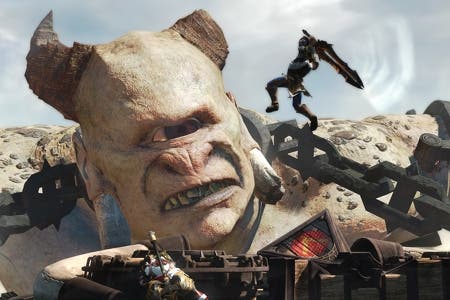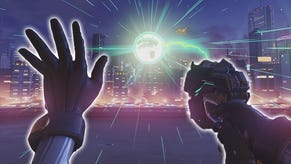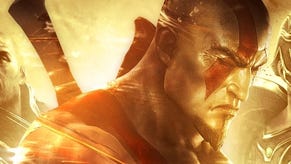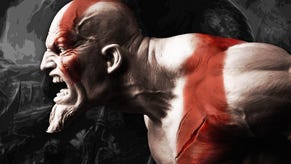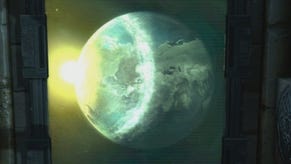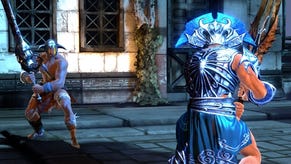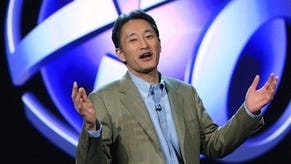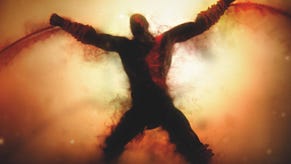God of War: Ascension Preview: Introducing the Gods of War
Communal bloodbath.
It's a brilliantly executed reveal. The first live demo to the press, I mean. Not the one that happened the previous week when, faced with more holes in its hull than it had PR fingers to poke in them, Sony gave up trying and rush-announced God of War: Ascension to stem the swelling tide of tittle-tattle.
The bit that was always supposed to be the actual reveal, though, taking place in a private theatre in Hollywood - "Welcome to one of the worst kept secrets in the industry!" chortles game director Todd Papy - opens with a superbly crafted piece of drama.
A brooding warrior, whom we are supposed to think is Kratos, is revealed by a retreating camera to be another muscular, Mardi Gras-attired brute entirely. Soon he's scrapping with a bulging, barmy cyclops and we're in familiar territory: classical hack-and-slash action of murderous beauty.
And then the camera teasingly shifts to the right to capture the entrance of a second warrior, who promptly wades in. The pair now gang up on the fabulously well-animated beast, one leaping onto its writhing shoulders to draw back its head, while the other guts it from waist-to-neck 'til it collapses in a jellied pool of its own spurting innards.

The duo jog off triumphantly through a door and Papy calls out: "Give me a taunt to prove it's live!" One of his team, who had up to this point been an unknown presence lurking at the rear of the theatre, promptly obliges as one of the warriors thrusts his sword skywards and they charge on.
That's how you announce multiplayer, God of War-style. And we've barely even started. A few moments later, the area opens up to reveal characters duelling all over. Because this is eight-player multiplayer. A few seconds more and a furious, horned titan, ensnared by chains, fills the screen. Because this is God of War.
And that, in one hugely impressive sequence, is Ascension's multiplayer in a nutshell: classic team-based action, coupled with the series' trademark technical bravura, epic scale and orgiastic celebration of savagery.
As the round rolls on, one of the teams eventually batters the other sufficiently to earn the right to take out the titan in a scene of quite spectacular violence. Having smashed its jaw in half, three of the warriors launch chains at the monster's enormous eyeball. While it strains and swells in the socket, the fourth player leaps towards it, motioning to run it through with a spear sent down from the heavens. A fraction of a second from impact, the demo cuts to black. I catch my breath.
Every combatant in the demo was controlled live by a member of the team, Papy notes, anticipating queries over how much of what we just saw was staged for effect.

Clearly the opening part was a bit, purely for the purposes of a dramatic reveal. But the rest, I am later assured, is a real map that will ship with the final game. It was hard to make sense of it all at first sight without commentary, to be honest, but it turned out we had witnessed a game of domination, with two teams battling to control two points on the map, after which the victor proceeded to the endgame.
The basic premise of multiplayer in Ascension is that the player can "go from an unknown hero to a god, following in the footsteps of Kratos," says Papy. You must ally yourself with one of four gods: Zeus, Poseidon, Hades or Ares - as in the original God of War when Kratos pledged his allegiance to the latter.
"Based on that selection you'll be able to gain magical abilities, items, different things you get from these unique gods that influence your style of play. In other games it would be considered your classes," says lead combat designer Jason McDonald.
As for the classes: "It's pretty similar to what you'd expect," he adds. "Some are based on damage, some are based on healing and sustaining, some on magical attacks. We don't want to reveal what each god will do just yet but you can expect some key differences.
"It's a team-based multiplayer experience and we want to make sure you're not always going with the same guy, like a game of Street Fighter where everyone picks Ryu."
The combat system is built on the same core mechanics as the rest of the series, with the same buttons pretty much doing the same thing. But change has been necessary to accommodate the broader scope of multiplayer. It's "powerful, brutal, kinetic, flashy and responsive," claims Papy, while retaining the "heart and soul" of God of War.

As indicated by the demo's opening scene, team-based attacks are a big part of the experience, with two-on-one and three-on-one takedowns possible. For the sake of balance, though, if a player is skilled enough he can still escape these situations and even turn them to his advantage.
The dynamic changes again when set-pieces like the titan takedown are considered. "What makes God of War epic?" Papy muses. "Killing a big guy does. That was the inception idea. How does that work in multiplayer? We're still going through that right now. What you saw today versus what we're going to ship with is going to change.
"For us what's fixed is the base combat. Now it's fleshing out the game modes and seeing what works, what doesn't work, and whether the players understand it.
"In multiplayer games your attention span... you can't have a whole bunch of objectives. So we're constantly focus testing: is this too much, are there too many things going on? Just that iteration process over and over again to find the magic formula."
All the focus for now is on multiplayer, but the team isn't forgetting what made the series a success in the first place.
"We didn't want to sacrifice single-player for multiplayer, neither did we want to tack [the latter] on," says McDonald. "We're definitely going full force with both."
What we do know is that Ascension single-player serves as a prequel to the series. You'll still be playing as Kratos, but: "It's the youngest you've ever seen him," says Papy. "We want to show a different side to him, bring more of the humanity back".
Given the demands of crafting a multiplayer experience from scratch, can we really expect single-player to be as substantial as what has gone before? "We're talking just a little bit shorter," Papy admits. "We've mapped out everything and given time estimates. It'll be pretty damn close."
All the way back to the original, God of War has proved a standard bearer for the graphical prowess of PlayStation platforms. PS2 bowed out in remarkable fashion with God of War II. And 2010's PS3 debut made its intentions clear with an opening sequence of astonishing ambition.
"We always strive to [top ourselves]," says Papy, bullishly adding: "Personally I think what we've got in the opening 20 minutes of this game will blow people away." Boastful, certainly, but when it looks as good as it does a year from release with eight people playing together, I wouldn't bet against it.
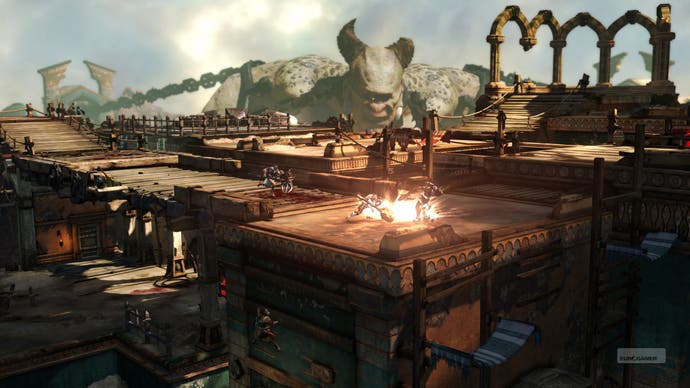
The technical challenges of recreating the visual spectacle of God of War in multiplayer without compromising the frame-rate are, as they say across the pond, not trivial. One advantage is the use of fixed cameras, carried over from single-player, so designers don't have to worry about players suddenly spinning the view around 180-degrees.
On top of that, numerous improvements to the God of War 3 engine have been made. Later on, we visit Sony Santa Monica itself where I see some of the new processes at the point of application.
It's all in the small details. Improved animation and a new collision system mean characters' bare feet now realistically adapt to uneven terrain; meanwhile, the climbing system has been rewritten to make point-to-point movement feel less like you're following a fixed path.
Over in the art department, meanwhile, shelves are lined with books on "Extreme Nature" and Michelangelo, while unsettlingly large anatomical models of the human body stand stiffly atop desks. To make a virtue of the desecration of flesh, one must first know it intimately.
If anything, the change of direction in Ascension seems to have re-energised a team at a time when fatigue and boredom could easily have crept in for what is its fourth massive God of War project on the trot, giving it fresh motivation to keep pushing the art of the possible - as well as the angry.
